| Article ID | Journal | Published Year | Pages | File Type |
|---|---|---|---|---|
| 1720245 | Applied Ocean Research | 2012 | 9 Pages |
In this study, according to the Mohr–Coulomb friction principle, two 3D liquefaction criteria are proposed based on the effective stresses state and the dynamic pore pressure, in which the cohesion and internal friction angle of soil (sand or silt) are both considered. Through the comparison investigation about the liquefaction in soil under wave–current loading, it is found that the cohesion and internal friction angle of soil have significant effect on the prediction of liquefaction zone under dynamic loading, such as wave and earthquake. The new liquefaction criteria proposed in this study can be degenerated to the form proposed by Okusa [16], Tsai [20] and Zen and Yamazaki [26]. It cannot be degenerated to the form proposed by Jeng [9]. It is indicated that there is no clear physical basis for the liquefaction criteria proposed by Jeng [9]. The area and maximum liquefaction depth of liquefaction zone in seabed would be overestimated greatly by the criteria proposed by Jeng [9].
► Two new 3D liquefaction criteria are proposed. ► They are based on effective stress and dynamic pore pressure, respectively. ► Cohesion and internal friction angle of soil are both considered. ► The proposed criteria can be degenerated to previous forms widely used. ► Comparison between proposed criteria and previous ones is conducted.
